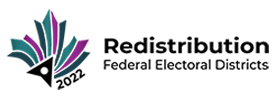Part C – Effective Representation of Indigenous Peoples – Ontario
In preparing our redistribution plan, the Commission considered the location of all First Nations reserves and communities and sought to ensure that no such community would be arbitrarily divided by an electoral district boundary.
If an electoral district included a First Nations reserve that had not participated in the Census, the Commission considered the population data available from the Indian Registration System as reported by Crown-Indigenous Relations and Northern Affairs Canada (CIRNAC) in proposing the boundary for that electoral district.
The Commission received expressions of appreciation for noting the distinctive challenges of effective representation in Northern Ontario.
However, as was fairly noted, the perspectives and needs in the
It was also importantly noted that Far North
and as Indigenous peoples are very different even from those of most of the residents of the other proposed Northern ridings.while the number of people is an important factor in setting electoral boundaries, so is geography and the accessibility of that geography.
The Commission received many valuable submissions with respect to the practical difficulties and inappropriateness of the proposed geographically large district of Kiiwetinoong—Mushkegowuk and its division of Treaty 9, Treaty 3 and Treaty 5 First Nations. These submissions will be discussed more fully under the geographic piece for Northern Ontario.
We also heard strong messages about keeping Tribal Councils intact and keeping First Nations together with municipalities with which they have important relationships. In addition, we were informed of significant off-reserve Indigenous populations living in those northern towns and cities that act as service hubs
for First Nations and as home base
for many Indigenous agencies. We have endeavoured to respect these relationships and off-reserve populations in our report.
The Commission proposed the addition of several Indigenous names for proposed districts. The Commission received generally positive responses to that aspect of its proposal. Many appreciated this gesture towards recognizing the vital presence and history of Indigenous peoples in our province.
It was suggested that the Commission add additional Indigenous names. As a result, the Commission requested additional input from Tribal Councils and First Nations as well as Métis leadership organizations on this concept. Specifically, the Commission wrote to these organizations requesting feedback on the proposed Indigenous names, and suggestions for any names that might be appropriately added to other proposed federal ridings.
With the benefit of these submissions and consultations, our redistribution plan has been improved.
However, the Commission is of the view that more can, and should, be done to address effective representation of Indigenous peoples. For example, the Commission's mandate and the legislated timeline (unlike the mandate of Ontario's Far North Electoral Boundaries Commission) did not allow for direct discussions with First Nations prior to the development of the proposed redistribution plan.
The Commission received recommendations that in recognition of Treaties and the Crown's commitment to Nation-to-Nation relationships with First Nations, in-person consultations – particularly in remote fly-in communities – supported by appropriate interpretation and translation, be undertaken.
As was stated, Canada has unique and constitutionally protected obligations to First Nations, and a commitment to reconciliation with them. The Commission urges Parliament to consider how best to address these obligations in the context of electoral district boundaries.
